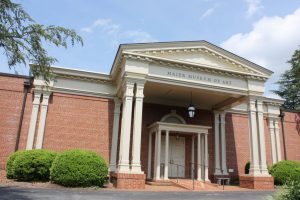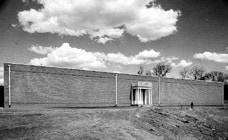About
 The Maier Museum of Art at Randolph College houses an outstanding collection of American art, chiefly paintings, works on paper, and photographs dating from the 19th, 20th, and 21st centuries. Located on the Randolph campus and open to visitors year-round, the Museum serves both the academic community and the general public and offers changing exhibitions, rotating displays of the College’s permanent collection, and educational programs.
The Maier Museum of Art at Randolph College houses an outstanding collection of American art, chiefly paintings, works on paper, and photographs dating from the 19th, 20th, and 21st centuries. Located on the Randolph campus and open to visitors year-round, the Museum serves both the academic community and the general public and offers changing exhibitions, rotating displays of the College’s permanent collection, and educational programs.
Virtually unique among colleges and universities for its continual building of a collection focused on American art, Randolph College provides many opportunities to its students. The Collection is used as a teaching tool in many courses, a museum studies program is offered through the art department, internships and work-study positions are available, and volunteer and social opportunities enhance the quality of campus life. A variety of visiting lecturers speak on the Collection and special exhibitions throughout the academic year, and the Helen Clark Berlind Symposium brings notable scholars and artists to campus in conjunction with the Annual Exhibition.
Randolph College also serves the larger community of Lynchburg and the Central Virginia region and continues to fulfill the hope expressed by early patrons, that our students and neighbors can “study objects of art frequently, seriously, and at leisure.” The public is welcome to visit throughout the year, and educational programs are available to all. The Maier staff and volunteer docents from the community also offer tours to local schools and other groups. Hands-on art programs for children and families are offered in conjunction with some special installations.
Mission Statement
The Maier Museum of Art exists to strengthen the academic curriculum and cultural life of Randolph College by encouraging aesthetic enjoyment, cultural understanding, and critical study of the visual arts, especially the Museum’s distinguished collection of American Art.
The Museum accomplishes its mission in two ways. First, it collects, preserves, researches, exhibits, and interprets works of American art. Second, it presents exhibitions and programs that either enhance its permanent collection or examine other artistic traditions, thereby broadening its educational scope.
The Maier serves the Randolph College community as its primary audience, but also extends its purview to local, state, and national audiences. By promoting a lifelong appreciation of the visual arts and their varied cultural contexts, the Maier Museum of Art strives to enrich the intellectual and cultural life of the College and the broader community.
The Collection
The Collection’s strengths lie in American Impressionism and in early 20th-century Realism. The Collection in general features excellent works illustrating the evolution of American art from the early 19th century to the present day. Among the artists represented are Gilbert Stuart, Thomas Cole, Winslow Homer, Mary Cassatt, Georgia O’Keeffe, and Andrew Wyeth. Significant holdings of drawings, prints, and paintings by Arthur B. Davies and Ben Shahn make the Museum an important center for the study of their work.
The College’s tradition of collecting art dates to 1907, when the senior class commissioned the well-known American artist William Merritt Chase to paint a portrait of the College’s first president, William Waugh Smith. Louise Jordan Smith, the school’s first professor of art (and President Smith’s cousin), played a crucial role in developing the art collection. A fervent believer that firsthand study of the art of one’s time was central to a liberal arts education, she established an annual exhibition of contemporary art on campus in 1911. It was from this series of exhibitions—which continue to this day—that the idea of a permanent art collection grew, and the first acquisition was made in 1914 from the 4th Annual Exhibition. Professor Smith ensured the continued growth of the collection with her 1928 bequest to establish an acquisition fund.
The art collection was exhibited throughout campus until 1977, when major works were moved to the current facility (constructed in 1952 by the National Gallery of Art to protect the national art collection in wartime). In 1981, Mr. and Mrs. William Thoresen donated funds to create a large new gallery at the Museum facility, and in 1982 the College received a generous gift from the Sarah and Pauline Maier Scholarship Foundation, Inc., for further improvements and to establish an endowment to support Museum operations. In 1983, the facility, simply known as the Art Gallery, was designated the Maier Museum of Art to honor the Foundation’s founder, William J. Maier (1903–1981). His daughter, Sara Maier Rowe, is an alumna from the Class of 1967. The Museum’s first official curator was appointed in the early 1980s, and the first director took office in 1988.
In keeping with Professor Smith’s intention that students be surrounded with original works of art, many objects are still displayed on campus, in offices and buildings such as Lipscomb Library and the recently renovated Student Center. The Collection’s most significant pieces are stored and exhibited at the Museum for security and environmental controls.
Project Y
 In the early winter of 1951 the campus of Randolph-Macon Woman’s College was chosen to be the site of a confidential storage facility for use by the National Gallery of Art (NGA) in the event of a national emergency. In the face of the nuclear threat posed by the Soviet Union, President Truman had ordered all government agencies to prepare for conflict. NGA administrators sought to safeguard the nation’s art treasures by building this specially-designed structure.
In the early winter of 1951 the campus of Randolph-Macon Woman’s College was chosen to be the site of a confidential storage facility for use by the National Gallery of Art (NGA) in the event of a national emergency. In the face of the nuclear threat posed by the Soviet Union, President Truman had ordered all government agencies to prepare for conflict. NGA administrators sought to safeguard the nation’s art treasures by building this specially-designed structure.
In exchange for the ownership and eventual use of the structure, the College agreed, in a contract signed in March 1951, to maintain and insure the facility and to make it available for emergency use by the NGA for a total of 50 years.
Given a secret code name, “Project Y,” by NGA administrators, the building was constructed under the supervision of NGA staff and with the support of the A. W. Mellon Educational and Charitable Trust. The structure was finished in the spring of 1952 and cost just under $250,000 to build. Simply called “the art gallery” by R-MWC faculty, staff, and students, the facility was dedicated December 11, 1952.
Throughout the 1950s and into the 1960s, NGA staff conducted periodic inspections to ensure that the building was well maintained and ready for use. Project Y, which after 1951 was never publicly acknowledged by the NGA as its storage facility, was listed in its emergency plans as a viable safe location as late as 1979. Despite permitting the College to renovate areas of the building in the late 1970s and early 1980s, the NGA insisted that storage racks removed to make space for two more exhibition rooms be kept on the premises for possible emergency use.
In the 1950s, 1960s, and early 1970s the College used the front rooms of the Art Gallery to display portions of its notable collection and for exhibitions. It was open to students and faculty of R-MWC as well as to members of the Lynchburg community. Obligated for several decades to the NGA in the event of a national emergency, the Art Gallery was not fully utilized by the College until renovations in the middle 1970s, funded by the National Endowment for the Arts, made the exhibition rooms more practical, attractive, and comfortable. Subsequent repairs and renovations in 1981-1982 and an endowment established by the Pauline and Sarah Maier Scholarship Fund, Inc., of Charleston, West Virginia, in 1983 transformed Project Y into the Maier Museum of Art known to today’s visitors.
Project Y—a product of Cold War fears—was never used by the National Gallery of Art for storage. Today, however, the building in essence does fulfill the best aspect of its original purpose, sheltering a collection of art for the education and enjoyment of future generations.
This text was originally developed for a 50th anniversary celebration in 2002-2003. For their research assistance, the Museum acknowledges: Archives of the National Gallery of Art staff; Lipscomb Library staff; Lynchburg Museum System staff; Mary Spencer Craddock; Donald M. Giles; William F. Quillian, Jr.; Robert A. Spivey; Nancy Mowll Mathews; Muriel Zimmerman Casey ’53; and Prof. Carolyn Bell ’65.